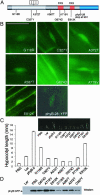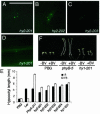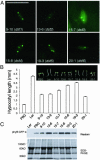Characterization of the requirements for localization of phytochrome B to nuclear bodies
- PMID: 14612575
- PMCID: PMC283619
- DOI: 10.1073/pnas.1935989100
Characterization of the requirements for localization of phytochrome B to nuclear bodies
Abstract
Phytochromes are red- and far-red-sensing photoreceptors that detect the quantity, quality, and duration of light throughout the entire life cycle of plants. Phytochromes accumulate in the cytoplasm in the dark. As one of the earliest responses after light illumination, phytochromes localize to the nucleus where they become associated with discrete nuclear bodies (NBs). Here, we describe the steady-state dynamics of Arabidopsis phytochrome B (phyB) localization in response to different light conditions and define four phyB subnuclear localization patterns: diffuse nuclear localization, small and numerous NBs only, both small and large NBs, and large NBs only. We show that phyB nuclear import is not sufficient for phyB NB formation. Rather, phyB accumulation in NBs is mainly determined by the percentage of the total amount of phyB protein that is in the active phyB conformer, with large NBs always correlating with strong phyB responses. A genetic screen to identify determinants required for subnuclear localization of phyB resulted in several phyB mutants, mutants deficient in phytochrome chromophore biosynthesis, and mutations in at least one previously uninvestigated locus. This study lays the groundwork for future investigations to identify the molecular mechanisms of light-regulated partitioning of plant photoreceptors to discrete subnuclear domains.
Figures





Similar articles
-
Regulation of phytochrome B nuclear localization through light-dependent unmasking of nuclear-localization signals.Curr Biol. 2005 Apr 12;15(7):637-42. doi: 10.1016/j.cub.2005.02.028. Curr Biol. 2005. PMID: 15823535
-
Functional analysis of a 450-amino acid N-terminal fragment of phytochrome B in Arabidopsis.Plant Cell. 2004 Aug;16(8):2104-16. doi: 10.1105/tpc.104.022350. Epub 2004 Jul 23. Plant Cell. 2004. PMID: 15273294 Free PMC article.
-
Dimers of the N-terminal domain of phytochrome B are functional in the nucleus.Nature. 2003 Jul 31;424(6948):571-4. doi: 10.1038/nature01837. Nature. 2003. PMID: 12891362
-
Nucleo-cytoplasmic partitioning of the plant photoreceptors phytochromes.Semin Cell Dev Biol. 2000 Dec;11(6):505-10. doi: 10.1006/scdb.2000.0202. Semin Cell Dev Biol. 2000. PMID: 11145880 Review.
-
Molecular mechanisms for mediating light-dependent nucleo/cytoplasmic partitioning of phytochrome photoreceptors.New Phytol. 2015 May;206(3):965-71. doi: 10.1111/nph.13207. Epub 2014 Dec 15. New Phytol. 2015. PMID: 26042244 Free PMC article. Review.
Cited by
-
Genome Sequencing of Arabidopsis abp1-5 Reveals Second-Site Mutations That May Affect Phenotypes.Plant Cell. 2015 Jul;27(7):1820-6. doi: 10.1105/tpc.15.00214. Epub 2015 Jun 23. Plant Cell. 2015. PMID: 26106149 Free PMC article.
-
Phytochrome activates the plastid-encoded RNA polymerase for chloroplast biogenesis via nucleus-to-plastid signaling.Nat Commun. 2019 Jun 14;10(1):2629. doi: 10.1038/s41467-019-10518-0. Nat Commun. 2019. PMID: 31201355 Free PMC article.
-
Mutant screen distinguishes between residues necessary for light-signal perception and signal transfer by phytochrome B.PLoS Genet. 2008 Aug 15;4(8):e1000158. doi: 10.1371/journal.pgen.1000158. PLoS Genet. 2008. PMID: 18704165 Free PMC article.
-
UV-B increases active phytochrome B to suppress thermomorphogenesis and enhance UV-B stress tolerance at high temperatures.Plant Commun. 2025 Jan 13;6(1):101142. doi: 10.1016/j.xplc.2024.101142. Epub 2024 Oct 10. Plant Commun. 2025. PMID: 39390743 Free PMC article.
-
Arabidopsis HEMERA/pTAC12 initiates photomorphogenesis by phytochromes.Cell. 2010 Jun 25;141(7):1230-40. doi: 10.1016/j.cell.2010.05.007. Cell. 2010. PMID: 20603003 Free PMC article.
References
-
- Kendrick, R. E. & Kronenberg, G. H. M. (1994) Photomorphogenesis in Plants (Kluwer Academic, Dordrecht, The Netherlands).
-
- Quail, P. H. (2002) Nat. Rev. Mol. Cell Biol. 3, 85-93. - PubMed
-
- Nagy, F. & Schafer, E. (2002) Annu. Rev. Plant Biol. 53, 329-355. - PubMed
-
- Fankhauser, C. & Staiger, D. (2002) Planta 216, 1-16. - PubMed
Publication types
MeSH terms
Substances
Grants and funding
LinkOut - more resources
Full Text Sources
Other Literature Sources
Molecular Biology Databases
Research Materials
Miscellaneous

